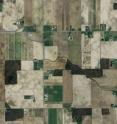Insecticides from genetically modified corn present in adjacent streams
In a paper published this week in the Proceedings of the National Academy of Sciences, Cary Institute aquatic ecologist Dr. Emma Rosi-Marshall and colleagues report that streams throughout the Midwestern Corn Belt are receiving insecticidal proteins that originate from adjacent genetically modified crops. The protein enters streams through runoff and when corn leaves, stalks, and plant parts are washed into stream channels. Genetically-modified plants are a mainstay of large-scale agriculture in the American Midwest, where corn is a dominant crop. In 2009, more than 85% of U.S. corn crops were genetically modified to repel pests and/or resist herbicide exposure. Corn engineered to release an insecticide that wards off the European corn borer, commonly referred to as Bt corn, comprised 63% of crops. The tissue of these plants has been modified to express insecticidal proteins, one of which is commonly known as Cry1Ab.
Following an assessment of 217 stream sites in Indiana, the paper's authors found dissolved Cry1Ab proteins from Bt corn present in stream water at nearly a quarter of the sites, including headwater streams. Eighty-six percent of the sampled sites contained corn leaves, husks, stalks, or cobs in their channels; at 13% of these sites corn byproducts contained detectable Cry1Ab proteins. The study was conducted six months after crop harvest, indicating that the insecticidal proteins in crop byproducts can persist in the landscape.
Using these data, U.S. Department of Agriculture land cover data, and GIS modeling, the authors found that all of the stream sites with detectable Cry1Ab insecticidal proteins were located within 500 meters of a corn field. Furthermore, given current agricultural land use patterns, 91% percent of the streams and rivers throughout Iowa, Illinois, and Indiana —some 159,000 miles of waterways—are also located within 500 meters of corn fields.
Rosi-Marshall comments, "Our research adds to the growing body of evidence that corn crop byproducts can be dispersed throughout a stream network, and that the compounds associated with genetically-modified crops, such as insecticidal proteins, can enter nearby water bodies."
After corn crops are harvested, a common agricultural practice is to leave discarded plant material on the fields. This "no-till" form of agriculture minimizes soil erosion, but it also sets the stage for corn byproducts to enter nearby stream channels.
Rosi-Marshall concludes, "The tight linkage between corn fields and streams warrants further research into how corn byproducts, including Cr1Ab insecticidal proteins, potentially impact non-target ecosystems, such as streams and wetlands." These corn byproducts may alter the health of freshwaters. Ultimately, streams that originate in the Corn Belt drain into the Mississippi River and the Great Lakes.
Source: Cary Institute of Ecosystem Studies
Articles on the same topic
- New study reveals that insecticides from genetically modified corn are present in adjacent streamsTue, 28 Sep 2010, 14:23:13 UTC
Other sources
- Insecticides from genetically modified corn present in adjacent streamsfrom PhysorgMon, 27 Sep 2010, 19:14:29 UTC
